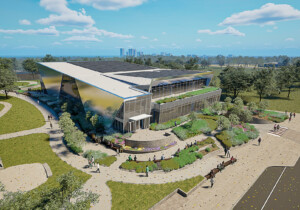Very much in the loop, the Vernacular Architecture Forum’s (VAF) book, Out of the Loop, is a collection of essays that survey Chicago’s architectural terrain from the standpoint of its neighborhoods. Published to accompany the VAF conference that was held in Chicago June 3–7, 2015, VAF’s self-identified guidebook, although rich with content, is better suited for the historian’s library than for a pocket guide to your next Chicago adventure.
Divided into two parts, Out of the Loop is diverse and filled with sociological content from Chicago’s abundant history. Edited by Virginia B. Price, David A. Spatz, and D. Bradford Hunt, Out of the Loop features essays from many prominent historians and offers insights into Chicago’s story. Part one, “Building Vernacular Chicago: Forming City Neighborhoods and Forging Communal Structures,” focuses and establishes the context for the city’s diverse architectural language; part two, “Touring Vernacular Chicago: Neighborhood Transition and Community Identity,” offers eight theme-specific tours across the city that identify neighborhoods in transition.
The book’s organizational structure represents the diversity found in the city’s neighborhoods. In part one, essays on race and ethnicity within neighborhoods border a guide to common building types throughout the city. For example, Terry Tatum’s piece, “A Brief Guide to Chicago’s Common Building Types,” which examines the diversity of common building types through material, style, location, and social class, follows David R. Roediger’s essay, “Racism, Ethnicity, and White Identity in Chicago”—a juxtaposition common in Chicago.
These cultural adjacencies continue throughout the book and help identify the broad Chicago vernacular. In part two, tours span across the city and even extend into Indiana.
The tours are not route specific, but it becomes clear that there is a common vernacular within each neighborhood. From murals in Pilsen to the intertwined culture along Diversey Parkway, these neighborhoods develop their own visual language within the structure of the grid, and the VAF highlights key moments in their emergence.
Although conference-based journals tend to keep information distinct within a singular field of study, part two does the exact opposite. It is refreshing to see professionals work together to produce a collective body of work. However, for the architect, Tatum’s building types and Spatz’s “Building Metropolitan Chicago’s Expressways” offer a micro- and macro-scale look at the impact buildings and borders can have in city planning. In addition, these topics fit well into Bill Savage’s exploration and detailed history of Chicago’s grid and are useful as a prelude to the tours in the second half of the book. While the book may not be graphically stimulating, and at moments appears dense, the essays make up for this through tracing the emergence of these vernaculars, which would be of interest for anybody curious about Chicago.
Before the Chicago conference, the VAF posed the question, “Why Chicago?” And for good reason. Within a relatively small region, the emergence of such diverse vernacular and social nuances is a treasure trove of knowledge for architects. Specifically, within the architectural community, there has been a growing interest in what Chicago’s neighborhoods have to offer. Beginning at the 2012 Venice Biennale, the Team Chicago: City Works members David Brown and Stanley Tigerman explored how Chicago’s neighborhoods could benefit from the injection of various architectural building types. Moreover, the Chicago Architecture Foundation in an upcoming exhibition titled, Chicago Futures: 50 Speculations for the 21st Century City, has asked 50 designers from Chicago to come up with ideas to improve the life of residents within their particular wards. It is unclear what trajectory these projects will take, but neighborhood-specific vernaculars will need to be addressed.
Although the VAF has not fully reached out to the public, the content shares a valuable story of Chicago’s history and can touch citizens in how they have defined their neighborhoods’ vernaculars. As an opportunity to become more inclusive, the upcoming VAF conference in Durham, North Carolina, titled From Farm to Factory: Piedmont Stories in Black and White (June 1–4, 2016) will examine the impact of segregation on the transformation of Durham. It is clear, the Vernacular Architecture Forum is in the loop, but what will it take for its members to reach out to a broader audience?










